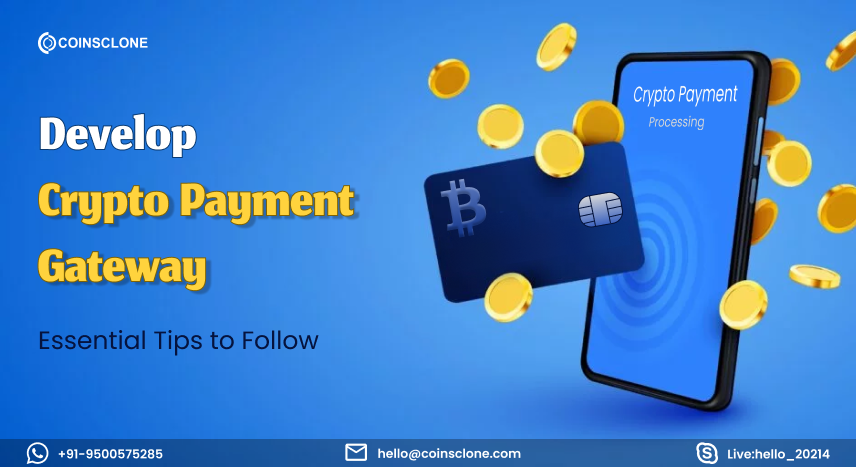The rapid adoption of cryptocurrencies has created exciting new opportunities for startups and entrepreneurs. One of the most impactful ventures in this space is building a crypto payment gateway. It is nothing but a platform that allows merchants and users to send, receive, and process payments in cryptocurrencies securely. But with innovation comes responsibility. When financial transactions are involved, security isn't a feature—it's a necessity.
In this blog, we’ll walk you through the essential steps to building a secure crypto payment gateway, what entrepreneurs should focus on, and how to ensure your platform is built to last. Let’s dive in.
Understand the Core Architecture First
Before writing a single line of code or hiring developers, it’s crucial to understand how crypto payment gateways work. At its core, a crypto payment gateway facilitates the transaction between the payer (user) and payee (merchant), validating and confirming transactions on blockchain networks.
A typical architecture includes:
-
Wallet integration for storing and transferring crypto assets
-
Blockchain nodes/APIs for real-time confirmation and synchronization
-
Merchant dashboards for tracking and settlement
-
Conversion tools to convert crypto to fiat (optional but common)
As a startup founder, you need to identify your niche — whether you're targeting e-commerce stores, freelancers, or gaming platforms. This decision shapes your tech stack, feature set, and user experience.
Prioritize Security from the Ground Up
Let’s be honest: crypto platforms are prime targets for cyberattacks. So, if you’re thinking of launching a payment gateway, security must be baked into the development process, not patched on later.
Here are key security measures every serious crypto gateway must implement:
-
End-to-End Encryption: All data — especially private keys and transaction info — should be encrypted both at rest and in transit.
-
Cold Wallet Storage: Only a small percentage of assets should be kept in hot wallets. Use multi-signature cold wallets for storing most funds offline.
-
2FA and Role-Based Access: Protect user accounts with two-factor authentication and give backend access based on role privileges.
-
Smart Contract Audits: If your platform uses smart contracts, get them audited by third-party security firms before going live.
-
DDoS Protection & Rate Limiting: Prevent spamming and brute-force attacks using cloud-based WAF and rate controls.
-
Compliance with KYC/AML: Build secure identity verification flows that meet global compliance standards.
Don’t treat these as optional. They're your foundation for trust.
Partner with the Right Crypto Payment Gateway development Team
This part can make or break your crypto journey. Many startups fail not because the idea is bad — but because the execution isn’t secure or scalable.
-
Look for a blockchain development team with proven experience in:
-
Web3 and crypto payment integration
-
Wallet development and custody solutions
-
Blockchain security best practices
-
Fintech compliance (GDPR, PCI DSS, KYC/AML)
Ask for case studies. Get clarity on how they manage vulnerabilities, handle scalability, and future-proof the system. Think of your development team not just as coders, but technology partners who can guide your roadmap.
Tips for Long-Term Security & Platform Sustainability
Building your crypto gateway is only the beginning. Keeping it secure is an ongoing commitment. Here are a few pro tips to ensure your platform remains resilient:
-
Regular Security Audits: Perform biannual penetration testing and codebase reviews.
-
Real-Time Monitoring: Use automated tools to monitor anomalies or suspicious activity.
-
Token Whitelisting/Blacklisting: Give merchants the ability to allow or block certain tokens to avoid scams.
-
Update Protocols Promptly: Stay updated with blockchain protocol changes and apply patches immediately.
-
Community Feedback Loops: Engage early adopters to report bugs or suggest improvements.
In short, treat your platform like a living organism — it needs maintenance, updates, and care to thrive. Also, if you are in need for essential tips and tricks to create a payment gateway, then have a look >>> Tips to create a secure crypto payment gateway.
Final Thoughts on building a crypto payment gateway securely!
The demand for crypto payment gateways is only going to rise. But so will user expectations and regulatory scrutiny. As a startup or entrepreneur, you’re entering a high-opportunity market that demands technical precision and trustworthiness.
The smartest move? Collaborate with professional crypto payment gateway developers who deeply understand blockchain infrastructure, security architecture, and financial compliance. Don’t cut corners. Your reputation — and your users’ assets — depend on it.
The crypto world rewards those who build boldly, but also wisely. If you’re ready to create a secure and scalable crypto payment gateway, invest in the right partners and build from a foundation of trust.



